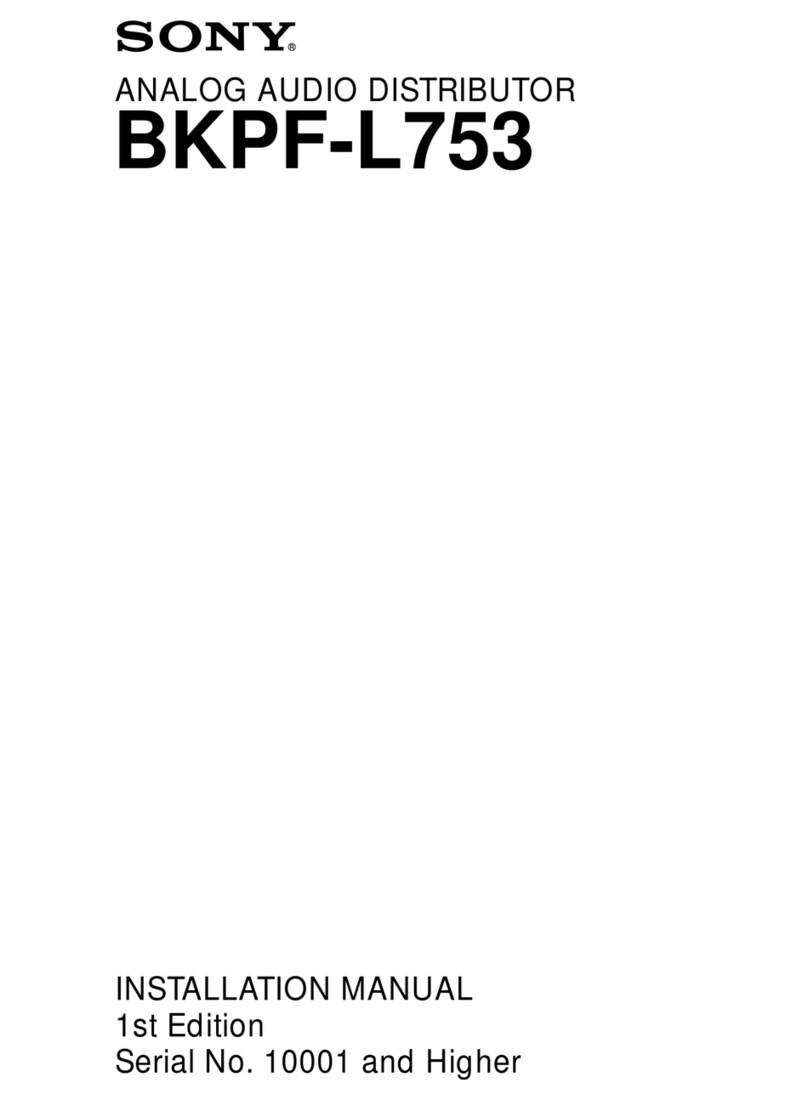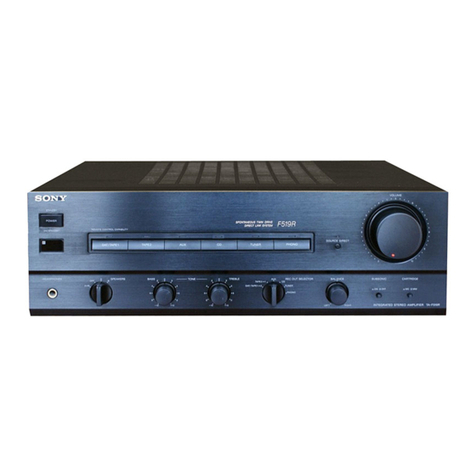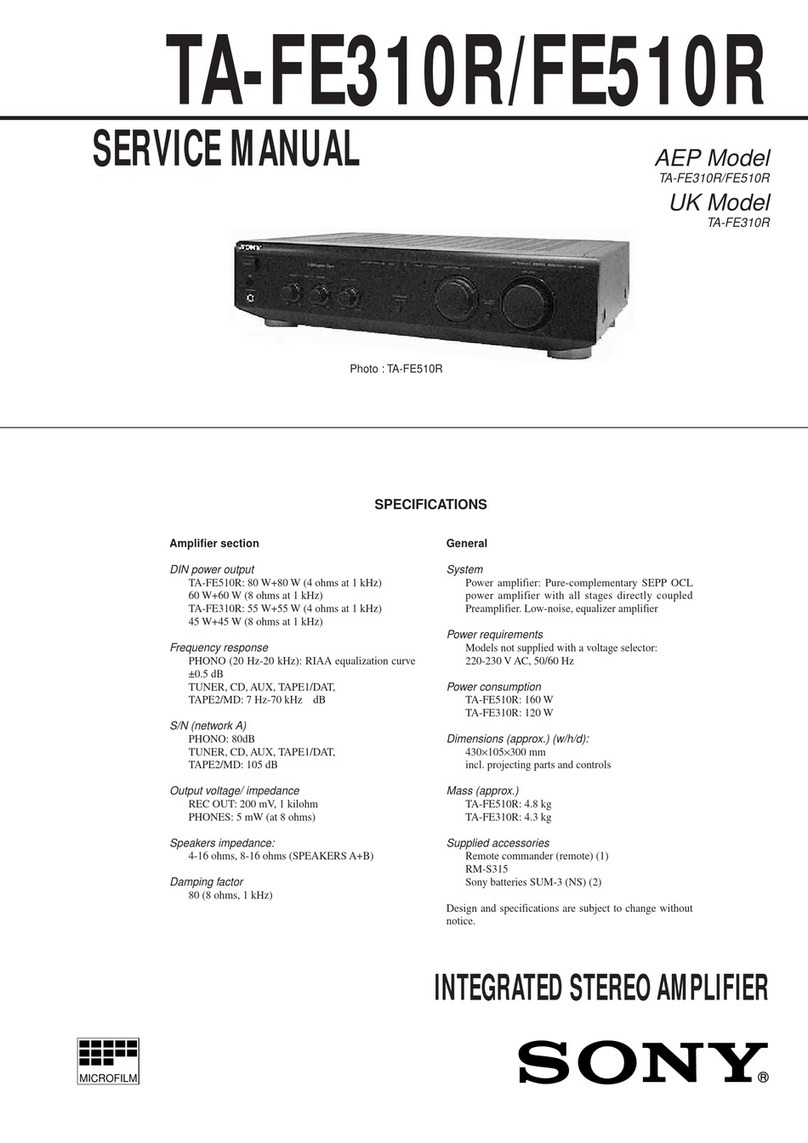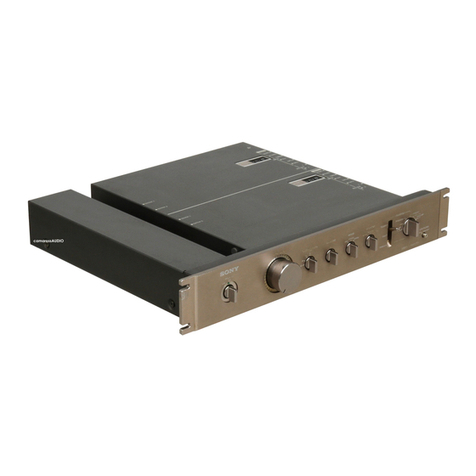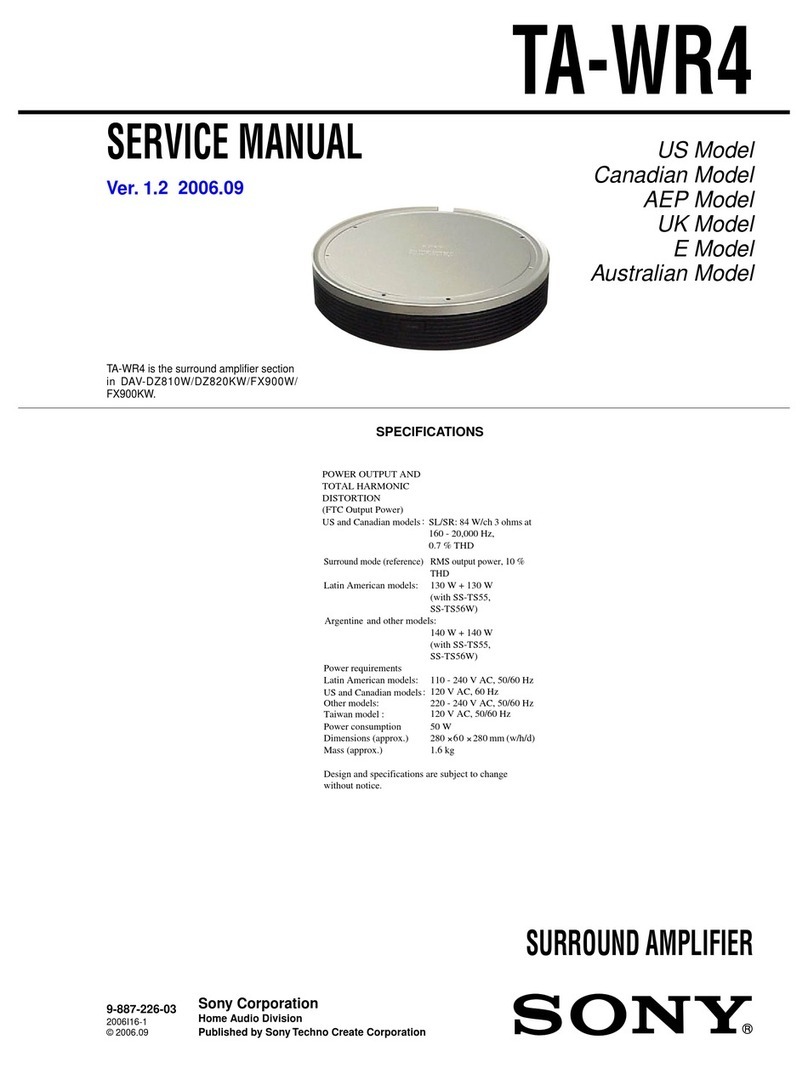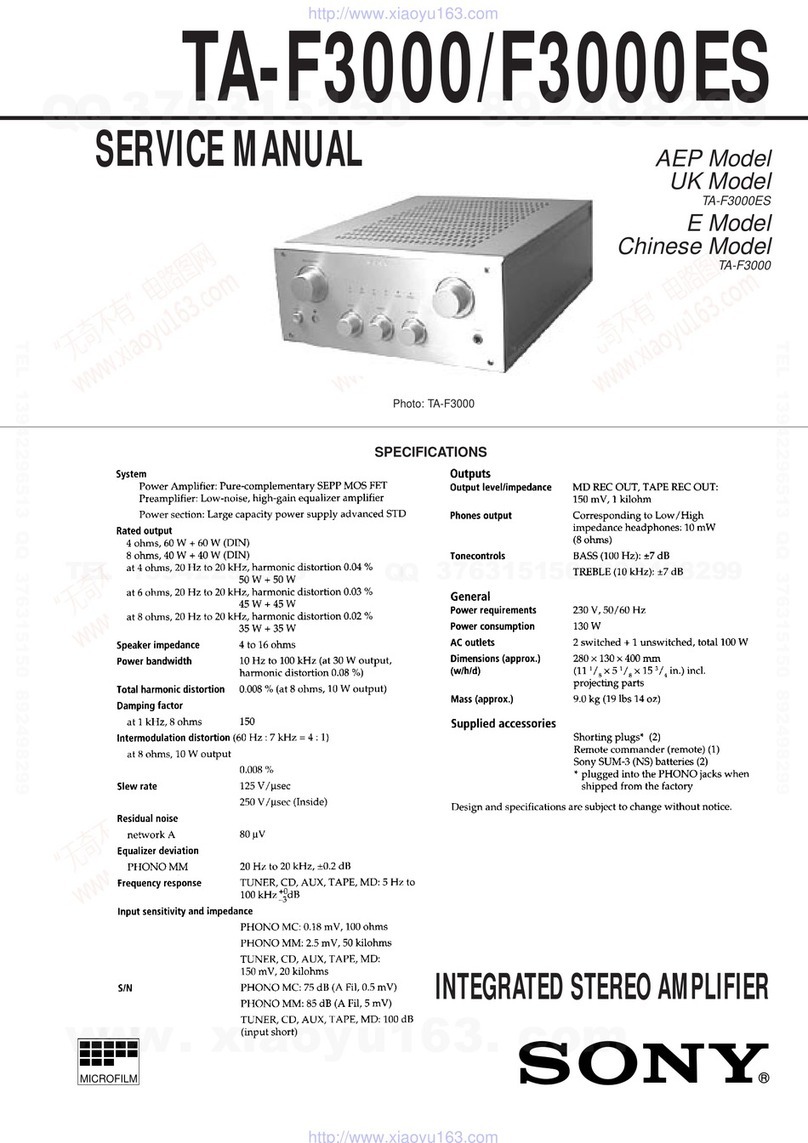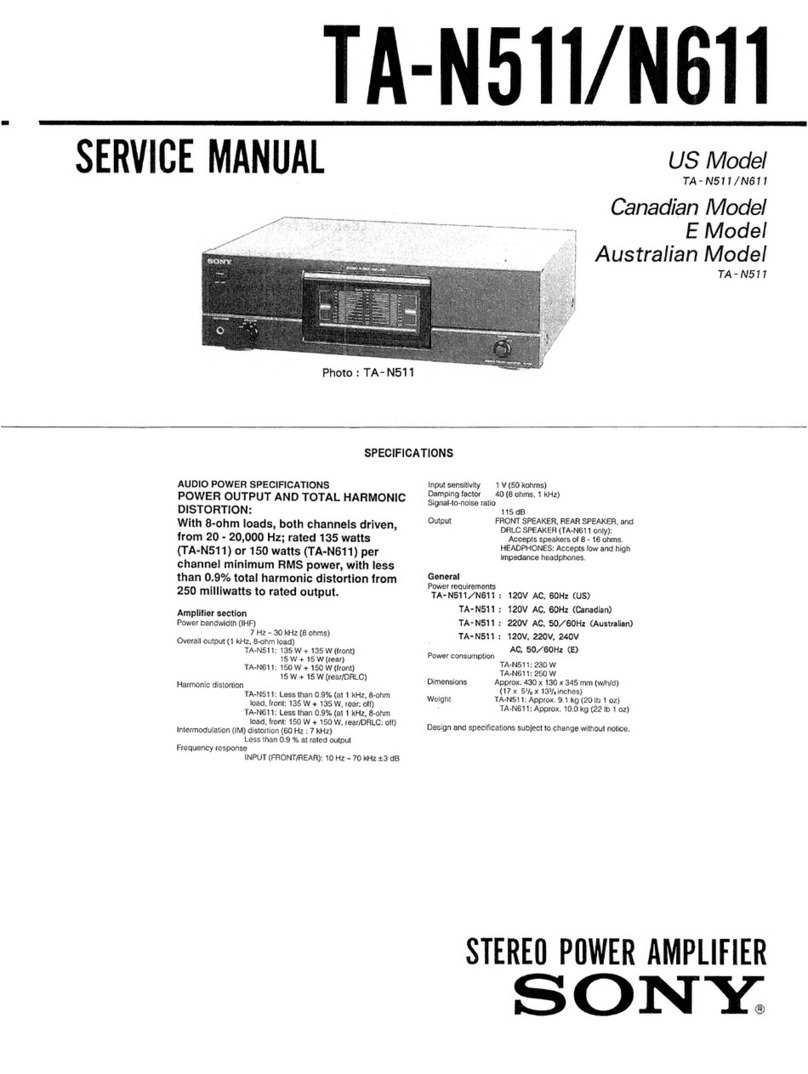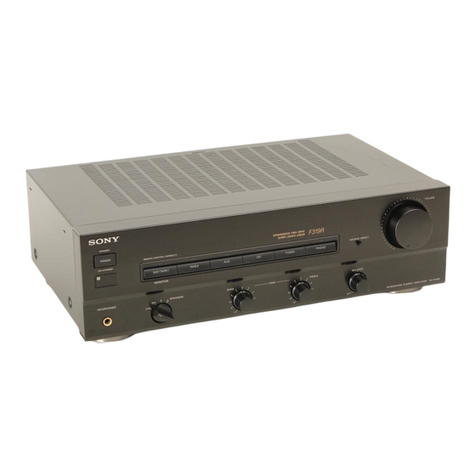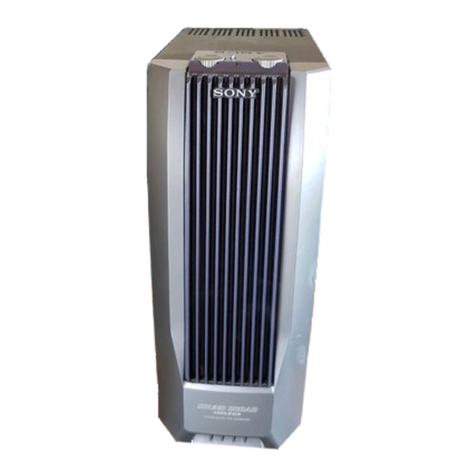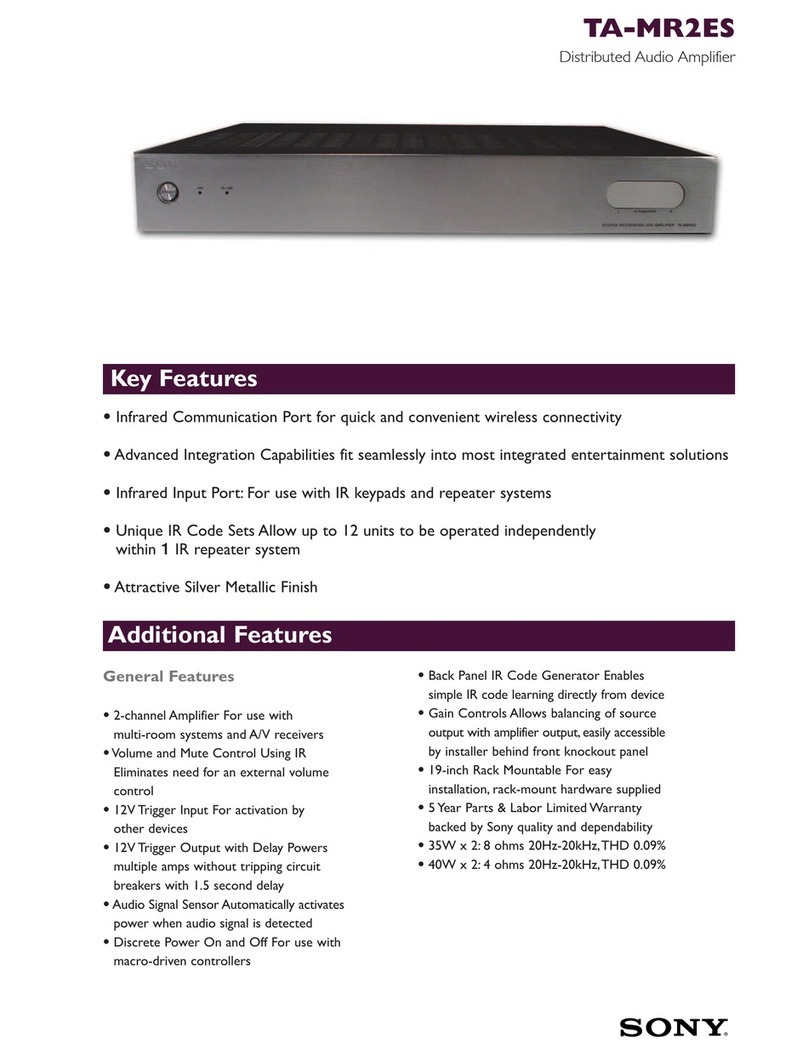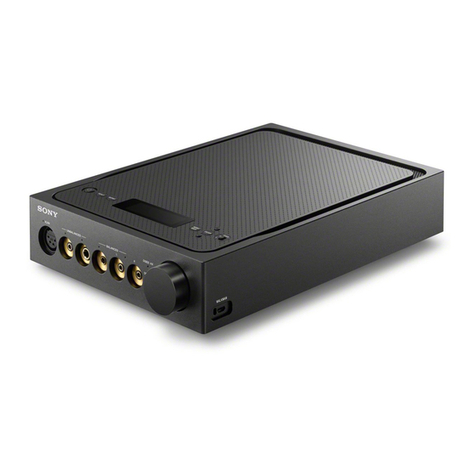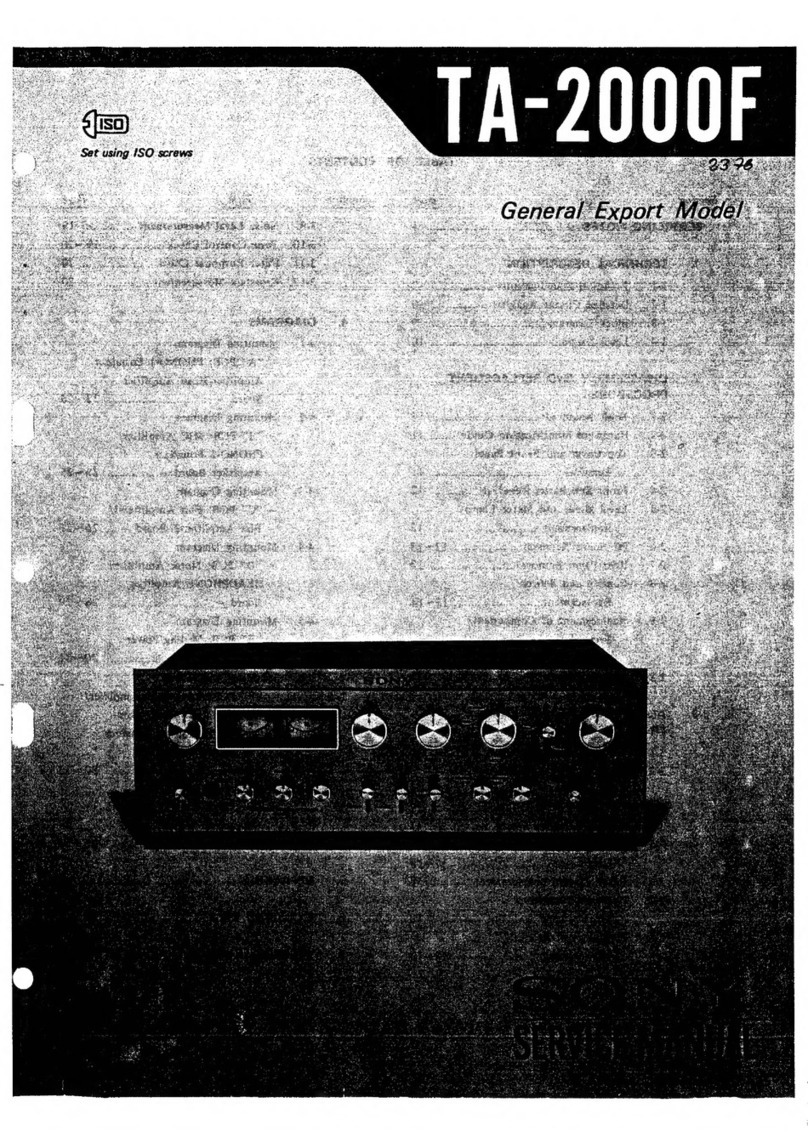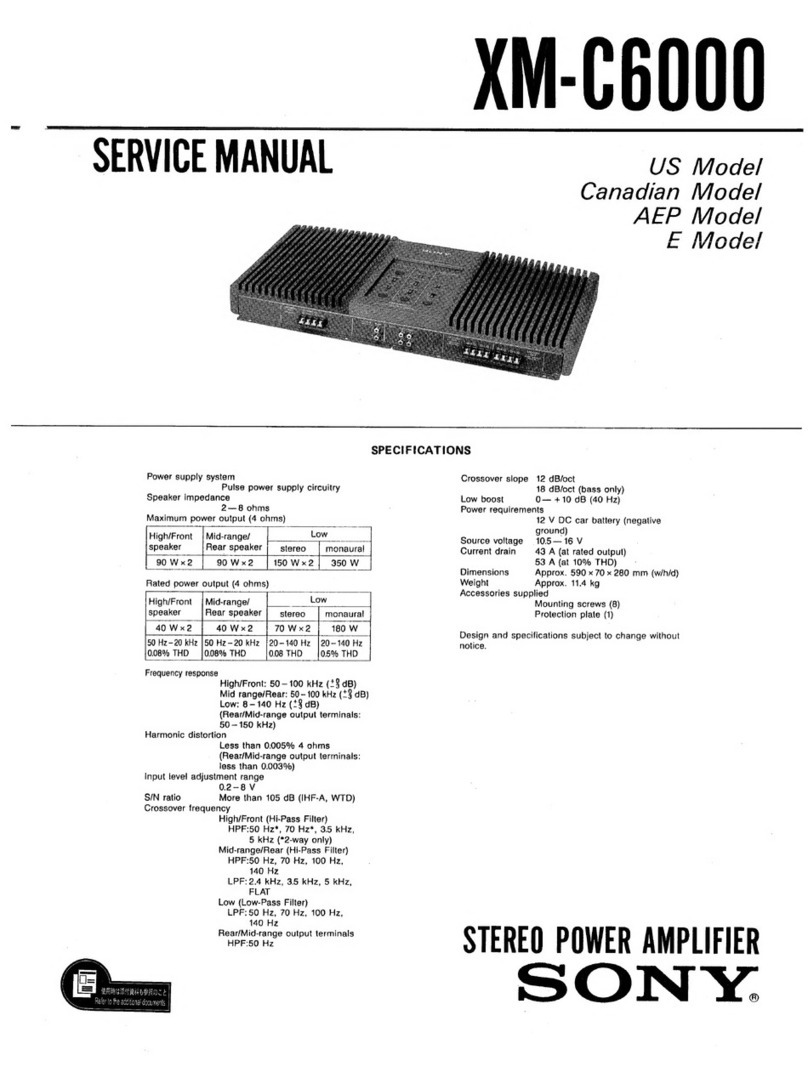
5
XM-D9001GTR
Fuse Replacement
If the fuse blows, check the power connection and
replace all fuses. If the fuse blows again after
replacement, there may be an internal malfunction.
In such a case, consult your nearest Sony dealer.
Warning
When replacing the fuse, be sure to use one
matching the amperage stated above the fuse
holder. Never use a fuse with an amperage rating
exceeding the one supplied with the unit as this
could damage the unit.
*
Protection circuit
This amplifier is provided with a protection circuit
that operates in the following cases:
— when the unit is overheated
— when a DC current is generated
— when the speaker terminals are shorted.
The PROTECTOR indicator lights up in red and the
unit will shut down.
If this happens, turn off the connected equipment,
take out the cassette tape or disc, and determine
the cause of the malfunction. If the amplifier has
overheated, wait until the unit cools down before
use.
If you have any questions or problems concerning
your unit that are not covered in this manual,
please consult your nearest Sony dealer.
Précautions
•Cet appareil est conçu pour fonctionner sur du
courant continu 12 V à masse négative.
•Utilisez des haut-parleurs d’une impédance
appropriée.
— 2 – 8 Ω.
•Ne raccordez pas de haut-parleurs actifs (avec
amplificateurs intégrés) aux bornes de haut-
parleurs de cet appareil. Cette opération pourrait
endommager les haut-parleurs actifs.
•N’installez pas l’appareil à un endroit exposé à :
—des températures élevées comme sous le
rayonnement direct du soleil ou près d’un
conduit de chauffage ;
—la pluie ou à l’humidité ;
—de la poussière ou à des saletés.
•Si votre voiture est garée en plein soleil et que la
température à l’intérieur de l’habitacle a
considérablement augmenté, laissez refroidir
l’appareil avant de l’utiliser.
•Lorsque vous installez l’appareil à l’horizontale,
veillez à ne pas recouvrir la grille d’aération avec
le tapis de sol, etc.
•Si cet appareil est placé trop près de l’autoradio
ou de l’antenne, il se peut que des interférences
se produisent. Dans ce cas, éloignez
l’amplificateur de l’autoradio ou de l’antenne.
•Si l’autoradio n’est pas alimenté, vérifiez les
branchements.
•Cet amplificateur de puissance utilise un circuit
de protection * visant à protéger les transistors et
les haut-parleurs en cas de dysfonctionnement de
l’amplificateur. Ne tentez pas de tester les
circuits de protection en couvrant l’accumulateur
de chaleur ou en branchant des charges
inadéquates.
•N’utilisez pas cet appareil avec une batterie
faible car les performances optimales de
l’appareil dépendent d’une bonne alimentation
électrique.
•Pour des raisons de sécurité, gardez le volume de
votre autoradio à un niveau permettant encore la
perception des bruits extérieurs.
•This unit is designed for negative ground 12 V
DC operation only.
•
Use speakers with suitable impedance.
— 2 – 8 Ω.
•Do not connect any active speakers (with built-in
amplifiers) to the speaker terminals of the unit.
Doing so may damage the active speakers.
•Avoid installing the unit in areas subject to:
—high temperatures such as from direct
sunlight or hot air from the heater
—rain or moisture
—dust or dirt.
•If your car is parked in direct sunlight and there
is a considerable rise in temperature inside the
car, allow the unit to cool down before use.
•When installing the unit horizontally, be sure not
to cover the fins with the floor carpet etc.
•If this unit is placed too close to the car audio
unit or antenna, interference may occur. In this
case, relocate the amplifier away from the car
audio unit or antenna.
•If no power is being supplied to the car audio
unit, check the connections.
•This power amplifier employs a protection
circuit* to protect the transistors and speakers if
the amplifier malfunctions. Do not attempt to test
the protection circuits by covering the heat sink
or connecting improper loads.
•Do not use the unit on a weak battery as its
optimum performance depends on a good power
supply.
•For safety reasons, keep your car audio unit
volume moderate so that you can still hear
sounds outside your car.
Precautions
Remplacement du fusible
Si le fusible grille, vérifiez le branchement de
l’alimentation et remplacez tous les fusibles. Si le
fusible grille encore après ce remplacement, il est
possible qu’il y ait un dysfonctionnement interne.
Dans ce cas, adressez-vous à votre détaillant Sony
le plus proche.
Avertissement
Lors du remplacement du fusible, veillez à
respecter l’ampérage indiqué au-dessus du
logement du fusible. N’utilisez jamais un fusible
d’ampérage supérieur à celui fourni avec
l’appareil, car cela pourrait endommager
l’appareil.
*Circuit de protection
Cet amplificateur est équipé d’un circuit de
protection qui s’active dans les cas suivants :
—en cas de surchauffe de l’appareil ;
—en cas de génération d’un courant continu ;
—lorsque les bornes de haut-parleurs sont court-
circuitées.
L’indicateur PROTECTOR s’allume en rouge et
l’appareil s’arrête.
Dans ce cas, éteignez tout équipement raccordé,
retirez la cassette ou le disque et déterminez la
cause du dysfonctionnement. Si l’amplificateur a
surchauffé, attendez que l’appareil refroidisse
avant de le réutiliser.
Si vous avez des questions ou des problèmes
concernant votre appareil qui ne sont pas abordés
dans ce mode d’emploi, adressez-vous à votre
détaillant Sony le plus proche.
Power Connection Wires
Câbles d’alimentation
Car audio unit
Autoradio Fuse (90 A)
Fusible (90 A)
+12 V car battery
Batterie de voiture +12 V
to a metal point
of the car
vers une partie
métallique de la
carrosserie
Make the terminal connections as illustrated below.
Effectuez les connexions des bornes comme illustré ci-dessous.
REM
+
12VGND
Pass the wires through the cap, connect the
wires, then cover the terminals with the
cap.
Note
When you tighten the screw, be careful not to
apply too much torque
*
as doing so may damage
the screw.
*
The torque value should be less than 1 N•m.
Faites passer les câbles par le cache,
raccordez les câbles, puis recouvrez les
bornes avec le cache.
Remarque
Lorsque vous vissez la vis, faites attention à ne
pas appliquer une trop grande force de torsion
*
,
car cela pourrait endommager la vis.
*
Le couple de torsion doit être inférieur à 1 N•m.
less than 450 mm (18 in)
moins de 450mm (18 po)
*
2
Remote output
*
1
Sortie de
télécommande
*
1
(REM OUT)
Notes on the power supply
•
Connect the +12 V power supply wire only after
all the other wires have been connected.
•
Be sure to connect the ground wire of the unit
securely to a metal point of the car. A loose
connection may cause a malfunction of the
amplifier.
•
Be sure to connect the remote control wire of the
car audio unit to the remote terminal.
•
When using a car audio unit without a remote
output on the amplifier, connect the remote
input terminal (REMOTE) to the accessory power
supply.
•
Use the power supply wire with a fuse attached
(90 A).
•
All power wires connected to the positive battery
post should be fused within 450 mm (18 in) of the
battery post, and before they pass through any
metal.
•
Make sure that the vehicle’s battery wires
connected to the vehicle (ground to chassis)
*
2
are
of a wire gauge at least equal to that of the main
power wire connected from the battery to the
amplifier.
•
Make sure that the wires to be connected to the
+
12 Vand GNDterminals of this unit are at least
4-Gauge (AWG-4) or have a sectional area of
more than 22.0 mm
2
(
7
/
8
in
2
).
Remarques sur l’alimentation électrique
•
Raccordez le câble d’alimentation +12 V
uniquement après avoir réalisé toutes les autres
connexions.
•
Raccordez correctement le fil de masse à une
partie métallique de la voiture. Une connexion
lâche peut provoquer un dysfonctionnement de
l’amplificateur.
•
Veillez à raccorder le fil de télécommande de
l’autoradio à la borne de télécommande.
•
Si vous utilisez un autoradio dont l’amplificateur
ne comporte pas de sortie de télécommande,
raccordez la borne d’entrée de la télécommande
(REMOTE) à la prise d’alimentation accessoires.
•
Utilisez un câble d’alimentation muni d’un fusible
(90 A).
•
Tous les fils électriques raccordés au support de
batterie positif doivent être protégés par un
fusible à une distance maximum de 450 mm
(18 po) du support de batterie et avant de passer
dans une partie métallique quelconque.
•
Assurez-vous que les fils de la batterie du véhicule
raccordés à ce dernier (sol au châssis)
*
2
sont d’un
calibre au moins égal à celui du fil électrique
principal reliant la batterie et l’amplificateur.
•
Assurez-vous que les câbles à raccorder aux
bornes+12Vet GNDde cet appareil sont d’un
calibre d’au moins 4 (AWG-4) ou d’une section
supérieure à 22,0mm
2
(
7
/
8
po
2
).
*1
If you have the factory original or some other car audio unit without a remote output on the
amplifier, connect the remote input terminal (REMOTE) to the accessory power supply.
In High Level Input Connection, car audio unit can also be activated without need for REMOTE
connection. However, this function is not guaranteed for all car audio units.
*1
Si vous disposez du modèle d’origine ou d’un autre autoradio dont l’amplificateur ne comporte pas
de sortie de télécommande, raccordez la borne d’entrée de télécommande (REMOTE) à la prise
d’alimentation accessoires.
Dans une connexion d’entrée à haut niveau, l’autoradio peut également être activé sans
raccordement à REMOTE. Toutefois, cette fonction n’est pas garantie pour tous les autoradios.

